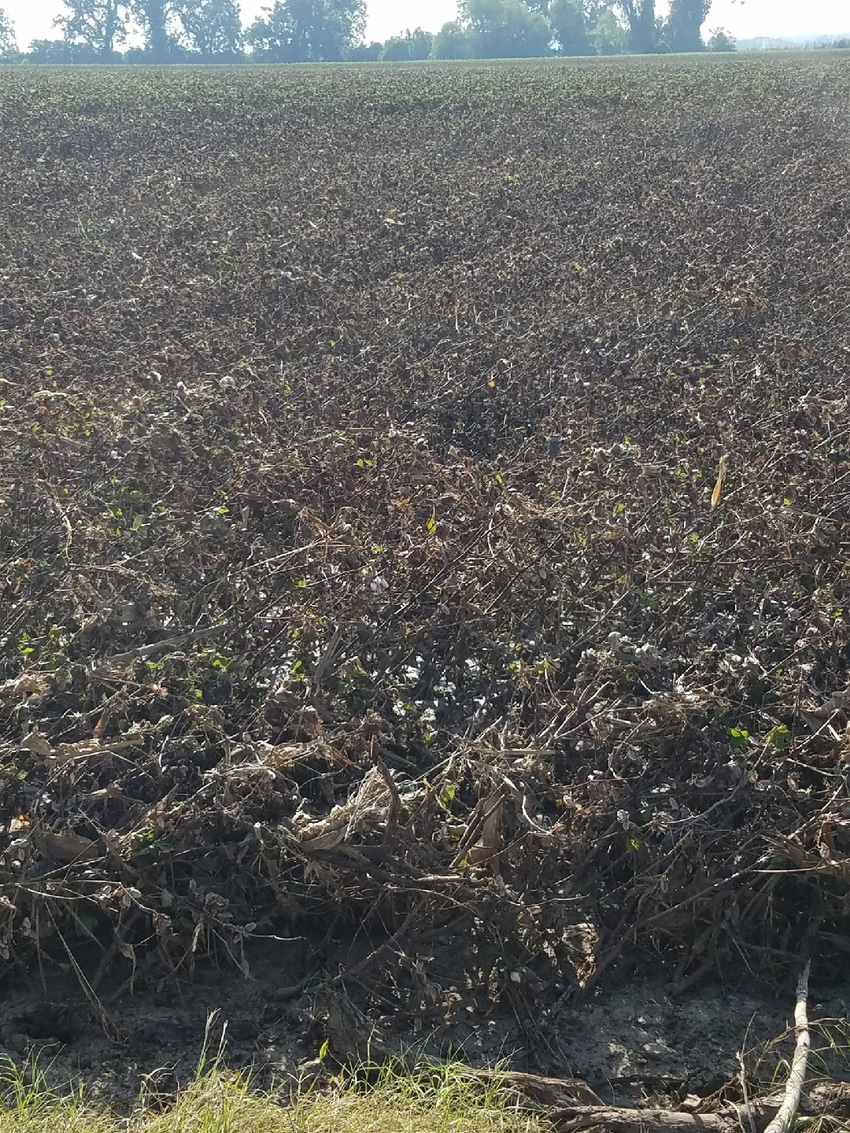
County between areas of Hurricane landfall and heavy rains loses most of cotton crop
The storm will mark three years in a row of heavy crop loss to many farmers in the region. For others this is two years of lost crops. Late-season rain damaged a lot of last year’s cotton. Cottonseed may be destroyed because of flooding and adulteration, according to FDA report.

“It’s bad,” says Clyde Crumley, a crop consultant working in Wharton County, Texas. “But it may not be the disaster I initially expected,” from Hurricane Harvey.”
Crumley says much of the area he works as a consultant lies between where Harvey made landfall packing winds to 150 miles per hour and Houston, where torrential rains fell for days, dropping more than 50 inches of rain and causing massive flooding.
Still, damage to what was “the best cotton crop I’ve seen since I’ve been down here,” will be devastating. “But a few days ago I thought we were looking at 100 percent loss. In recent days, after looking at fields, I think we will have some ginnable cotton.”
He says quality will be off, and farmers will face discounts, but they will harvest some cotton. He “guesstimates” that about 40 percent of the crop had been harvested, and some of that was damaged or destroyed on flooded gin yards. He anticipates some seed sprouting and little value for cottonseed.
“We had a great, high quality cotton crop coming in,” Crumley says. “Every acre was affected to some degree.”
He says damage came mostly from water. “We had 16 inches of rain over a few days. Some areas had a little less. We had 30 mile per hour winds that strung cotton out, and some rain blowing sideways in the wind, but we didn’t get the severe wind damage the Hurricane caused where it came ashore [Rockport], and we didn’t get the heavy rains they got to the east.”
Crumley says flooding came mainly from the Colorado River and tributaries. “The area flooded all the way to Bay City.”
The storm will mark three years in a row of heavy crop loss to many farmers in the region. For others this is two years of lost crops. Late-season rain damaged a lot of last year’s cotton. “I don’t think all of them will be able to recover from this,” Crumley says. Insurance will help, he adds, but some with more limited policies will not get coverage to cover all their acreage.
“We needed to make a crop this year,” he says. Farmers had completed grain harvest, but with grain prices so low, most were counting on cotton—high yields and good quality—to make up some of the shortfall. Crumley also notes that some elevators flooded and grain was ruined.
He says some farmers may go out of business following this latest disaster, not because they were bad farmers but because they just had bad luck.
“It’s a little better than I initially expected,” he says. “At least some farmers will have something to harvest. And we seem to be in for some dry weather. We need it.”
His optimism is limited. Crop insurance will not cover the value of what farmers might have made from the crop. “We have some cotton to harvest. But it’s still a bad loss,” he says.
MORE REPORTS
Reports across the region support Crumley’s outlook. Latest Texas AgriLife Extension updates indicate “Hurricane Harvey and its after-effects have the coastal cotton industry reeling.”
Dr. John Robinson, College Station, in the latest Crops and Weather Report, said harvest activities were 40 percent complete leading up to the arrival of Hurricane Harvey and estimated 300,000 to 400,000 bales of cotton were still on the stalk prior to the storm.
“One producer I talked to said three quarters of his cotton was on the ground from the heavy rain and high winds,” he said.
Harvested cotton could also be affected, he said.
Dr. Josh McGinty, AgriLife Extension agronomist, Corpus Christi, said cotton in his area would be fine since damaging winds and flooding occurred further north.
“There was some damage to modules but north, Refugio County and beyond, they’re in pretty rough shape,” he said.
McGinty said reports indicate cotton modules scattered by high winds or standing in water.
“There was a lot of cotton in modules sitting in gin yards or on the roadside,” he said. “There was a lot of flooding and wind so that could damage those modules and decrease grades. It’s not just yield losses, there are likely to be losses in quality.”
“Seed will be worth less due to sprouting, and that means those producers will have to pay extra to cover the cost of ginning,” he said. “In areas where modules remained wet for extended periods of time, we could see aflatoxin, which means if the levels are high enough, seed cannot be safely utilized as feed.”
Crumley contacted Farm Press early Thursday and reported FDA likely will declare "all edible portions of a crop exposed to flood waters to be adulterated and should not enter the human food channels." See the FDA report http://bit.ly/2xdWCur
That could mean "all our cottonseed," Crumley said.
McGinty said another potential problem is damage sustained by cotton gin facilities within the hurricane’s path.
“There was damage to gins, but I am not sure to what extent at this point,” he said. “The gin in Bayside is likely done for the season. That just adds to a whole host of issues producers face right now and that will play out over the next few weeks.”
About the Author(s)
You May Also Like





